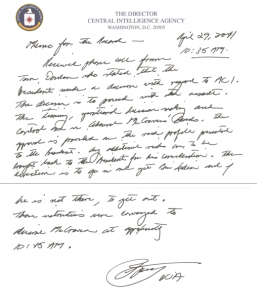Government Invokes Valerie Plame to Argue CIA Acknowledgment that Bush Authorized Torture Is Not Official Acknowledgment
As you’ll recall, back in April I went on a week-long rant about the great lengths–including submitting a secret declaration from the National Security Advisor–the Obama Administration had gone to hide a short reference to the September 17, 2001 “Gloves Come Off” Memorandum of Notification. In doing so, it appears the Obama Administration hid George Tenet’s invocation of the Presidential MON that authorized the capture and detention of terrorists but which the Bush Administration used as its authorization to torture those alleged terrorists. (post 1, post 2, post 3, post 4, post 5, post 6, post 7)
In a classified hearing on March 9, the government claimed that releasing the reference in question would “reveal[] for the first time the existence and the scope of” what now clearly appears to be the MON. After I went on my rant, the ACLU informed the Circuit Court that the claim might be false. If the reference was indeed to the MON, ACLU wrote, then the CIA had already revealed that the September 17, 2001 MON authorized torture in this litigation.
If true, it may be relevant to this Court’s consideration that the CIA officially acknowledged the existence of that memorandum in this very litigation.
In response to appellees’ Freedom of Information Act request, the CIA identified as responsive “a 14-page memorandum dated 17 September 2001 from President Bush to the Director of the CIA pertaining to the CIA’s authorization to detain terrorists” and “to set up detention facilities outside the United States.” Eighth Declaration of Marilyn A. Dorn
On Friday, the government responded, effectively saying that Marilyn Dorn’s declaration doesn’t count as official acknowledgement of the MON.
For the reasons set forth in the Government’s classified filings, the disclosures identified in plaintiffs’ letter, including the information provided in the Dorn declaration, do not constitute an official disclosure of the information redacted from the OLC memoranda.
Notably, in its discussion of the cases which it cited to support its claim that Dorn’s description of the MON doesn’t count, it also included language that would address John Rizzo’s extensive blabbing about the MON as well as Glenn Carle’s CIA Publication Review Board-approved reference to CIA having received a Finding covering torture (neither of which the ACLU mentioned in its letter). But look what case they cited to make that argument.
This Court applies “[a] strict test” to claims of official disclosure. Wilson v. CIA, Read more →


